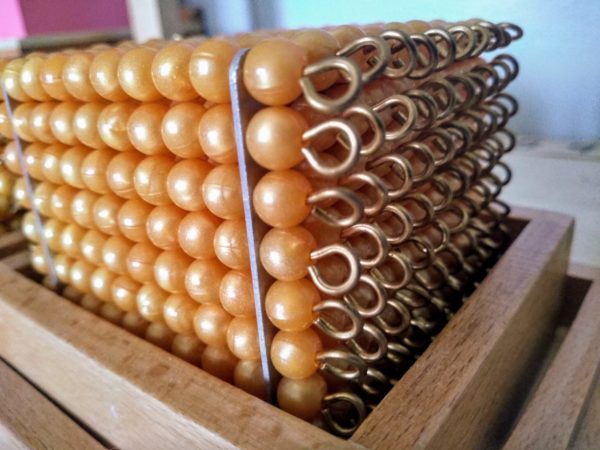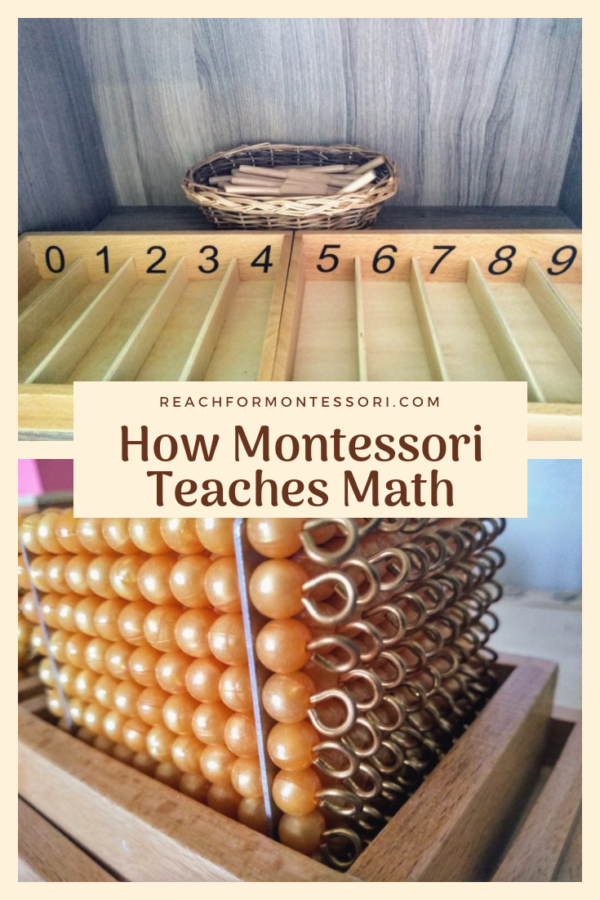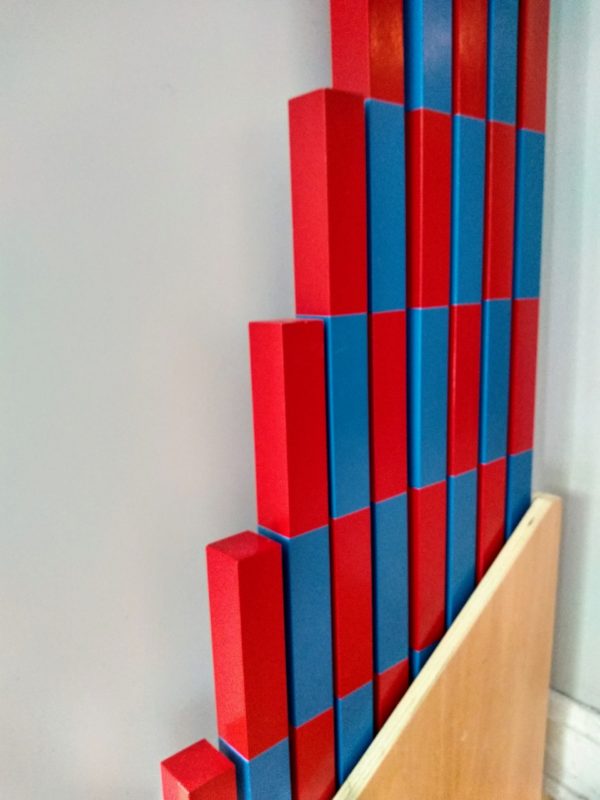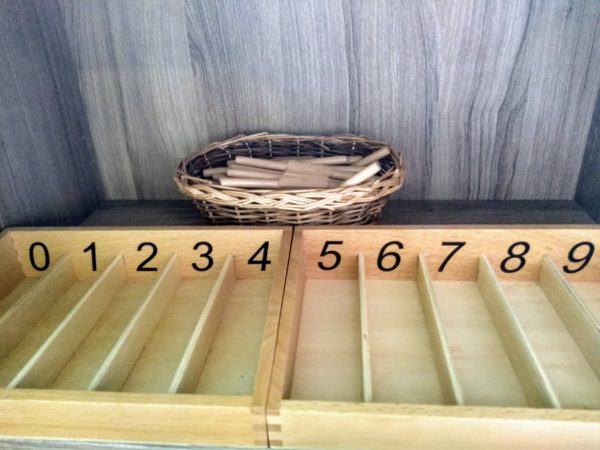Let's talk about how Montessori teaches math, shall we?
I wrote a while back about how Montessori math blends seamlessly with the recently implemented Common Core Standards, here in the U.S.
I've talked about the Golden Bead Material, the Spindle Boxes, and the Zero Game. Those articles gloss over how specific Montessori materials that are used to teach math.
I'd like to go, though, into a little more detail, for those who may be on the fence about whether or not they want their child to learn math the Montessori way.

Dr. Montessori surmised that our minds are naturally mathematical. This makes sense, as we wouldn't have progressed as a species without the practical application of math.
And math is, and will always be, a part of our every day lives.
When our kids want to share half of their sandwich with their sibling; that's math. Or when we set the table and we have to figure out how many plates are needed; that's math.
Montessori also believed children crave order and precision. Walk into any proper Montessori classroom and you will see how the Montessori environment and materials contribute to the development of a child's mathematical thinking.
The materials are placed in a certain sequence. Even the objects on the trays are placed in the order in which they are to be used!

Montessori math and the developing brain
Maria Montessori felt that, given the proper foundation and the freedom to explore and experiment, the understanding and excitement of math is sure to follow. Her materials were designed with Montessori math in mind.

The foundation for Montessori math comes from other Montessori activities.
Practical Life activities help children develop a sense of order and logical thinking. Sensorial materials help kids develop visual discrimination.
Culture and science materials help the child learn to explore and inquire. Language activities help the child prepare for later math by emphasizing sequence, classification, and matching….amazing!
Most importantly, every Montessori activity has the child using their hands.
Dr. Montessori believed, and many researchers since have concurred, that learning by manipulating objects and learning through the senses (touch, in this case) creates stronger connections in the brain.
How Montessori teaches math
Montessori teaches math in order from concrete to abstract. For those new to Montessori, an example of “concrete” is a child holding three marbles.
A step toward abstraction is telling the child, “You are holding three marbles.” The reason this is taking a step toward the abstract is because the number three was an abstract concept until the child got to experience what “three” was.
So, now the child is connecting number symbols with the quantities they represent!

From here, the memorization of math facts can be slowly introduced.
Memorizing math facts is more meaningful when a child who has had the opportunity to spend an extended amount of time becoming familiar with quantities, through the use of manipulatives.
Is Montessori math effective?
In short, absolutely!
Montessori math gives children visual and tactile representations of the numbers they are working with.
With this foundation, children as young as 4 can be observed in a Montessori classroom working out addition, subtraction, multiplication, and division with numbers in the thousands!
In fact, Montessori math doesn't begin with simple addition. Here is an example of one of the first addition problems a child might see:
2475 + 7141
What is the reason for starting children working with such large numbers, you might ask? For someone not familiar with Montessori, this might seem like unnecessary pressure on a young child.
But, the answer is so simple and makes so much sense…
The child who completes this math problem has done 4 simple addition problems, essentially.
That's a lot of practice!
And because Montessori has children using the Golden Bead Material along with these math problems in the primary years, children are aware of the quantities they are working with. It's not rote memorization.
This means less intimidation as the child advances.
12+75 is a piece cake after working with numbers in the thousands!
Are you following?
Children who learn math the Montessori way are more confident in their math skills, they have a deeper understanding of quantities, and they feel free to experiment and make errors, as the process is emphasized over the product.
This is what makes Montessori math effective.
So, this was an overview on how Montessori teaches math and why it's such an effective method.
I hope you enjoyed reading this as much as I enjoyed writing this! I have a few more Montessori math activities to present to Madeline (5) and then William (3) will be old enough for some Montessori primary lessons at home!
I'm excited to see how different children (Trust me…they are very different!) take to Montessori!
Cheers! And don't forget subscribe!

Pingback: Montessori Math: The Spindle Boxes — The Montessori-Minded Mom
Pingback: The Concept of Zero in Montessori — The Montessori-Minded Mom
It’s so interesting to think about a toddler doing math. I remember feeling so much anxiety when I was younger having to memorize my times tables. Am I’m still not very good at it haha I worry that my mental block in math will affect how well my toddler does in math. Do you have any recommendations on what materials I should start with. My son just turned 3 about 2 months ago. Thank you for all your help!
how DOES the child learn to add ? is the only way to use a tens board?
@Aminath Haifa Naeem,
the Seguin boards is not for addition. The purpose id primarily to teach the name changes which occur when two specific quantities are placed next to each other. For example the child knows the quantity 10 and also thee quantity 1. But when you place ten and one next to each other THE NAME CHANGES to eleven. The quantities do not change just THE NAME.